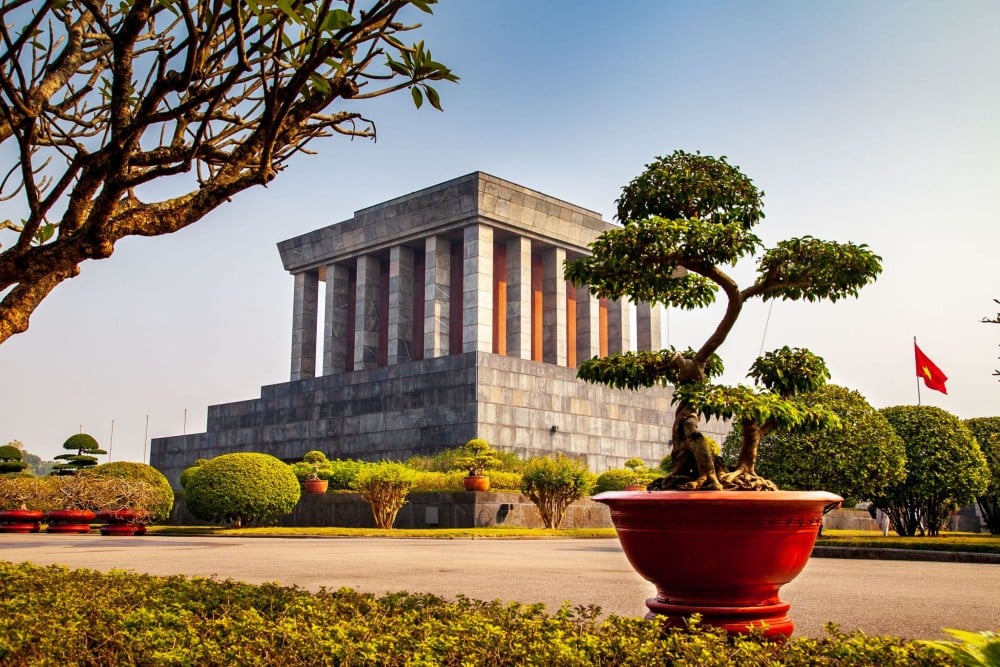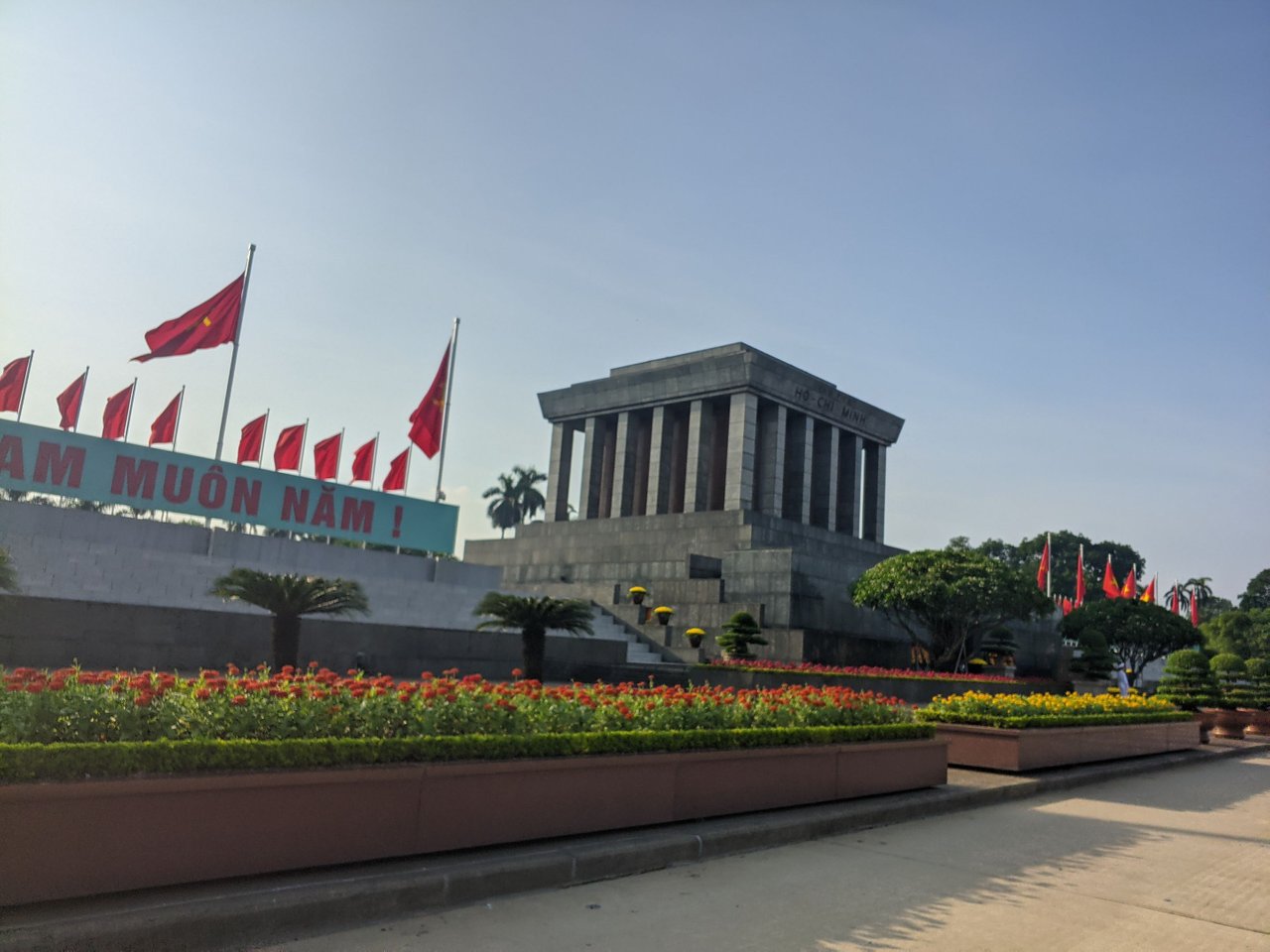Ho Chi Minh Mausoleum: Must-See Hanoi Landmark

Introduction to Ho Chi Minh Mausoleum in Hanoi
History of Ho Chi Minh Mausoleum
The Ho Chi Minh Mausoleum in Hanoi, Vietnam, is a large memorial building in Ba Dinh Square. It was constructed to pay homage to the Vietnamese revolutionary leader Ho Chi Minh, who played a crucial role in the country's struggle for independence from colonial rule.
The idea for the mausoleum was proposed immediately after Ho Chi Minh's death on September 2, 1969. The structure was inspired by Lenin's Mausoleum in Moscow and was designed by architect Ernst Heinkel. Construction began in 1973, and the mausoleum was officially inaugurated on August 29, 1975.
Significance and importance of Ho Chi Minh Mausoleum
The Ho Chi Minh Mausoleum holds immense significance for the Vietnamese as it symbolizes their respect and admiration for their beloved leader. It serves as a place for people to pay their respects to Ho Chi Minh, whose embalmed body is preserved inside the mausoleum.
The mausoleum also attracts visitors from around the world who come to learn about the history of Vietnam and its struggle for independence. It is a reminder of the sacrifices made by Ho Chi Minh and his comrades in the fight against colonial powers.
Overall, the Ho Chi Minh Mausoleum stands as a solemn and dignified tribute to a man who dedicated his life to the liberation and unification of Vietnam. It continues to be an important cultural and historical landmark in Hanoi, drawing in tourists and locals alike.
Architecture of Ho Chi Minh Mausoleum
Design and layout of the Mausoleum
The Ho Chi Minh Mausoleum in Hanoi, Vietnam, is a striking memorial structure that exudes reverence and grandeur. Situated in Ba Dinh Square, the mausoleum's design draws inspiration from Lenin's Mausoleum in Moscow, reflecting the monumental nature of its purpose. The architect, Ernst Heinkel, envisioned a structure that would command respect and honour for the Vietnamese revolutionary leader, Ho Chi Minh.
The mausoleum's layout is designed to create a sense of solemnity and contemplation, with its imposing facade and spacious interior echoing the importance of the figure it commemorates.
Materials used in the construction
The construction of the Ho Chi Minh Mausoleum utilized high-quality materials to ensure durability and magnificence. The exterior of the mausoleum is predominantly built using grey granite, symbolizing strength and permanence. The polished surfaces of the granite reflect the sunlight, adding to the grandeur of the structure.
The interior features marble sourced from different regions of Vietnam, each piece meticulously selected to enhance the overall aesthetic and symbolic value of the mausoleum. These materials not only contribute to the structural integrity of the building but also serve to honour Ho Chi Minh by creating a space that embodies his legacy and the values he stood for.
Ho Chi Minh Mausoleum Opening Hours and Location
Visiting hours of the Mausoleum
The opening hours of the Ho Chi Minh Mausoleum in Hanoi are strictly adhered to, with visitors allowed entry only during specific times. Check the official website or local guides for the most up-to-date information on visiting hours. Visitors are expected to maintain a respectful demeanour while inside the mausoleum and are typically required to observe silence as a sign of reverence for the late leader.
Location within Hanoi and nearby attractions
Situated in the heart of Hanoi, the Ho Chi Minh Mausoleum is surrounded by a cluster of significant landmarks and attractions that offer visitors a glimpse into Vietnam's rich history. The mausoleum's proximity to the Presidential Palace, One Pillar Pagoda, and Ho Chi Minh Museum makes it a popular destination for those interested in learning more about the country's heritage and the life of Ho Chi Minh.
Additionally, the expansive Ba Dinh Square provides a serene environment for contemplation and reflection.

Ho Chi Minh Mausoleum Dress Code and Visitor Guidelines
Appropriate attire for visiting
When visiting the Ho Chi Minh Mausoleum in Hanoi, it is essential to adhere to the dress code with respect to the late leader. Visitors are expected to dress modestly and avoid wearing clothing that is deemed inappropriate for a place of reverence. It is advisable to wear clothes that cover the shoulders and knees to show reverence for the solemnity of the mausoleum.
Visitor rules and regulations to be followed
As a visitor to the Ho Chi Minh Mausoleum, it is imperative to follow the established rules and regulations to maintain the sanctity of the site. Silence is to be observed within the premises as a mark of respect towards Ho Chi Minh and his legacy.
Photography is strictly prohibited inside the mausoleum, and visitors are expected to refrain from any form of photography or recording to uphold the solemn atmosphere.
:max_bytes(150000):strip_icc()/ho_chi_minh_mausoleum-5927c27b5f9b585950712069.jpg)
Ho Chi Minh Mausoleum Eternal Resting Place of Uncle Ho
Ho Chi Minh's embalmed body
Ho Chi Minh's embalmed body is preserved within the Ho Chi Minh Mausoleum in Hanoi, symbolising respect and reverence for the late leader. Visitors who enter the mausoleum will have the opportunity to pay their respects to Ho Chi Minh by viewing his preserved body, an experience that many find solemn and moving.
Preservation techniques used
Ho Chi Minh's body is preserved using meticulous techniques to maintain its lifelike appearance. Specialized embalming methods are employed, along with constant monitoring and maintenance, to ensure the body remains well-preserved. These preservation techniques highlight the deep respect and admiration that the Vietnamese people hold for Ho Chi Minh.

Ho Chi Minh Mausoleum Surrounding Gardens and Memorials
Gardens and monuments around the Mausoleum
The Ho Chi Minh Mausoleum in Hanoi is surrounded by meticulously manicured gardens and solemn monuments. These green spaces and structures serve as additional areas for contemplation and paying tribute to Ho Chi Minh. Visitors often reflect quietly as they walk through these serene surroundings.
Meaning behind the architectural elements
The architectural elements of the Ho Chi Minh Mausoleum are designed to evoke a sense of reverence and honour for Ho Chi Minh. The building's grandeur, with its imposing structure and solemn facade, symbolizes the late leader's importance and legacy. Each architectural detail, from the materials used to the layout of the site, is carefully planned to create a space of respect and remembrance.

Ho Chi Minh Mausoleum Historical and Political Significance
Role of Ho Chi Minh in Vietnamese history
When examining Vietnamese history, you will find that Ho Chi Minh played a pivotal role in the country's liberation and unification efforts. His leadership during the struggle for independence against colonial powers left a profound impact on the nation's identity and collective memory.
Political importance of the Mausoleum
The Ho Chi Minh Mausoleum holds significant political importance as it serves as a symbol of the Vietnamese government's reverence for the late leader. It stands as a testament to the ruling ideology and values, emphasizing the ongoing influence of Ho Chi Minh's principles on the country's governance and direction.

Ho Chi Minh Mausoleum Souvenirs and Gift Shop
Souvenirs available for purchase
When you explore the Ho Chi Minh Mausoleum in Hanoi, don't forget to visit the gift shop that offers a variety of souvenirs for purchase. From traditional Vietnamese handicrafts to postcards and keychains, you can find unique items to commemorate your visit to this historic site.
Unique items related to Ho Chi Minh
At the gift shop near the Ho Chi Minh Mausoleum, you will discover unique items that are closely related to Ho Chi Minh himself. These can include books about the late leader, miniature replicas of iconic landmarks, and artwork depicting significant moments in his life. These items serve as meaningful reminders of Ho Chi Minh's enduring legacy.
